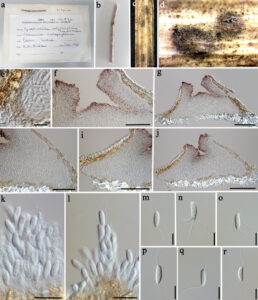Ajrekarella polychaetriae Kamat & Kalani, Mycopath. Mycol. Appl. 24: 300 (1964)
Index Fungorum number: IF 325947; Facesoffungi number: FoF 07102
Saprobic on dead stems of Jasminum calophyllum (Oleaceae). Sexual morph: Undetermined. Asexual morph: Conidiomata 550–760 μm diam., 220–380 μm high, brown to dark brown, pycnidial, mostly solitary, occasionally gregarious, immersed to semi-immersed, oval to subglobose, unilocular, thick-walled, glabrous, ostiolate. Ostiole 165–390 × 130–320 μm, conical to triangular, single, centrally located. Conidiomatal setae pale brown to dark brown, lining the area of dehiscence, unbranched, septate at base, straight or curved, smooth and thick-walled, tapered to acute apices. Conidiomata wall 10–50 μm wide, composed of thick-walled, hyaline to brown cells of textura angularis. Conidiophores hyaline, septate, irregularly branched, arising from the inner layer cells of conidiomata. Conidiogenous cells 9–20 × 2–4 μm, hyaline, enteroblastic, annellidic, cylindrical to subcylindrical, with up to 4 annellations. Conidia 12–17 × 4–6 μm ( ̄x = 14 × 4.8 μm; n = 30), hyaline, fusiform to broadly naviculate, narrow and truncated at the base, acute at the apex, aseptate, guttulate, bearing tubular, filiform, flexuous appendages (13–24 μm long) at both ends, apical appendage mostly 1, occasionally 2, unbranched, arising from the top of the conidia, basal appendages 2–5, unbranched or rarely forked.
Material examined – India, Poona, on the stems of Jasminum calophyllum (Oleaceae), I.K. Kalani, February 1961 (IMI 101970, holotype).
Notes – The conidiomatal setae presented in the original description (Sutton 1967b, 1980), but not observed in the present study.

Figure 1. Ajrekarella polychaetriae (IMI 101970, holotype) a, b Herbarium specimen. c, d Appearance of brown to dark brown conidiomata on the host. e, h–i Sections of peridium. f Ostiole. g, j Vertical section of conidiomata. k–l Conidiophores, conidiogenous cells and developing conidia. m–r Conidia. Scale bars c = 200 μm, d = 500 μm, e = 20 μm, f, h, i = 100 μm, g, j = 200 μm, k–l = 20 μm, m–r = 5 μm
